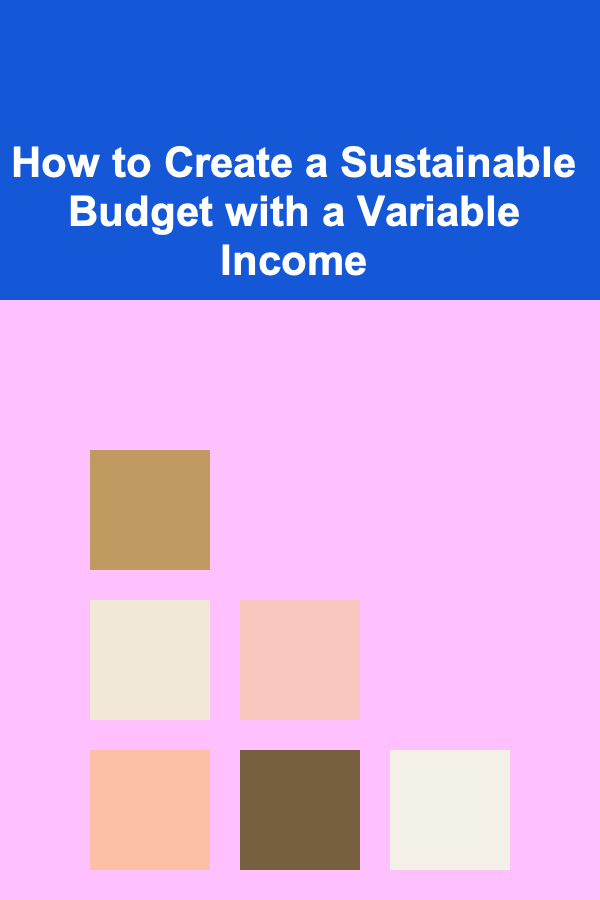
How to Create a Sustainable Budget with a Variable Income
ebook include PDF & Audio bundle (Micro Guide)
$12.99$5.99
Limited Time Offer! Order within the next:

Creating a sustainable budget can be a daunting task, especially when your income fluctuates. For many, earning a steady paycheck makes budgeting relatively straightforward. However, for those who experience variable income, such as freelancers, entrepreneurs, or seasonal workers, crafting a budget that works is more challenging but not impossible. With the right approach and mindset, you can manage your finances effectively, ensure that you have enough funds to cover your essential needs, and still save for the future.
In this guide, we will explore how to create a sustainable budget when you have a variable income. We'll cover key strategies to help you plan, adapt, and control your finances, even in times of uncertainty.
Understand Your Income and Expenses
The first step in creating a sustainable budget is understanding both your income and expenses. While this may seem obvious, it's particularly critical when you have variable income, as you might not always have the same earnings each month. Here's how to begin:
Track Your Income
Unlike a fixed income, your earnings may vary week to week or month to month. Begin by tracking your income over the past few months to understand the range of fluctuations. For example, if you're a freelancer, you may have periods of high earnings followed by months of lower pay. Understanding this fluctuation will allow you to anticipate income highs and lows and plan your budget accordingly.
- Keep a record: Maintain detailed records of your earnings, either in a spreadsheet or by using budgeting software.
- Determine your average income: While you may have fluctuating income, you should calculate the average monthly income based on your earnings over the past 6 to 12 months. This figure can serve as your baseline.
Track Your Expenses
The next step is to assess your monthly expenses. Variable income budgeting is not just about managing income, but also ensuring that your spending is within your means during lean months.
- Categorize your expenses: Divide your expenses into fixed (e.g., rent, utilities, insurance) and variable (e.g., groceries, entertainment, transportation).
- Review past months' expenses: Just as with income, track your expenses for a few months to identify patterns. This will give you insight into where you tend to overspend and where you can potentially cut back.
- Prioritize your expenses: Once you've identified your essential expenses, ensure that you have enough funds to cover them during leaner months. Non-essential expenses should be flexible and adjustable depending on your income.
Set Realistic Goals
Budgeting with variable income requires a careful balance between being realistic about your spending limits and ambitious about your financial goals. It's important to set goals that are achievable and aligned with your financial reality.
Establish Financial Priorities
When your income fluctuates, it becomes crucial to establish financial priorities. Determine what is essential for your well-being and what can be adjusted when funds are low.
- Emergency fund: Having an emergency fund is the cornerstone of any sustainable budget. With variable income, an emergency fund helps cushion the financial blow during months of low earnings. A good rule of thumb is to have three to six months' worth of living expenses saved in an easily accessible account.
- Debt repayment: If you have outstanding debt, prioritize paying it off. Even during low-income months, it's important to allocate some money toward debt repayment, if possible, to avoid accumulating high-interest charges.
- Savings and investments: Even with an unpredictable income, it's crucial to save and invest for the future. The amount you can save may fluctuate, but consistently contributing to your retirement account, an investment fund, or a high-yield savings account is essential.
- Discretionary spending: Treat discretionary spending, such as dining out or entertainment, as flexible categories. When money is tight, it's okay to reduce these expenses temporarily.
Create a Buffer for Uncertainty
Given that your income may fluctuate, it's important to build a financial cushion to handle periods of unpredictability. For instance, during high-earning months, set aside a percentage of your earnings to carry you through slower months. This buffer can help ensure that you don't dip into debt or have to drastically cut back on essential expenses.
Implement the 50/30/20 Rule
One of the most widely recommended budgeting methods is the 50/30/20 rule, which can be adapted to fit the needs of someone with a variable income.
50% for Needs
The first 50% of your budget should go toward essential expenses. These are the non-negotiable items necessary for your day-to-day living. This category includes:
- Rent or mortgage payments
- Utilities (electricity, water, etc.)
- Groceries and household necessities
- Insurance (health, auto, etc.)
- Transportation (fuel, public transit)
If your income is variable, allocate the minimum required to cover your needs each month. If you find that you're earning more than usual in certain months, consider putting the surplus into savings or debt repayment.
30% for Wants
The next 30% should go toward discretionary expenses or "wants." These are non-essential items that improve your quality of life but aren't absolutely necessary. Examples include:
- Dining out
- Entertainment (movies, concerts, subscriptions)
- Travel and vacations
- Shopping for non-essential items
In months when your income is lower, reduce this spending. In higher-earning months, you can afford to allocate a bit more to this category, but always ensure that the essentials are covered first.
20% for Savings and Debt Repayment
The final 20% should go toward savings and debt repayment. This portion is particularly important in creating a long-term sustainable budget. Here's how you can divide this category:
- Emergency savings: Add to your emergency fund to ensure that you're financially secure for the future.
- Retirement savings: Contribute to your 401(k), IRA, or another retirement account to secure your future.
- Debt payments: If you have outstanding debts, allocate some of this percentage to making progress on your debt repayment.
If your income is variable, this portion of your budget might vary each month, but aim to maintain the 20% split whenever possible. In months when your income is lower, consider cutting back slightly on savings and debt repayment but avoid eliminating it completely.
Use the Envelope System for Variable Expenses
The envelope system is a tried-and-true budgeting technique that can help you control variable expenses. While it might sound old-fashioned, it can be highly effective in ensuring you don't overspend.
How the Envelope System Works
The concept is simple: divide your discretionary spending categories (like groceries, entertainment, and personal expenses) into separate envelopes, each containing a set amount of cash for the month. Once the envelope is empty, you cannot spend any more in that category until the next month.
- Assign amounts: Each month, allocate a set amount of cash for each variable expense. For example, if your monthly grocery budget is $400, put $400 in an envelope labeled "Groceries."
- Track spending: As you make purchases, take the money from the respective envelope. This makes you more mindful of your spending and encourages you to stick to your budget.
- Adjust for income fluctuations: If your income is higher than usual, you can increase the amount of money in your envelopes for certain categories. If it's lower, reduce the amount accordingly.
The envelope system works particularly well for categories that are prone to over-spending. By using cash, you can easily track how much you have left to spend, and it prevents you from relying on credit cards or impulsive purchases.
Prepare for Tax Season
One of the biggest challenges for people with variable income is preparing for taxes. When you earn a fixed income, taxes are automatically deducted from your paycheck, but when your income fluctuates, you may be responsible for paying your taxes at the end of the year.
Set Aside Money for Taxes
If you're self-employed or have an income that is not subject to automatic withholding, it's important to set aside a portion of your earnings for taxes. A general rule of thumb is to set aside 25-30% of your income for tax purposes.
- Track tax deductions: As a freelancer or self-employed individual, you may be eligible for various tax deductions, such as home office expenses, business supplies, or vehicle-related costs. Be sure to keep track of these throughout the year.
- Quarterly tax payments: If you're self-employed, consider making quarterly estimated tax payments to avoid a large lump sum at the end of the year. This will help you manage cash flow and avoid penalties for underpayment.
Stay Flexible and Adjust as Needed
One of the most important aspects of creating a sustainable budget with a variable income is the ability to stay flexible. Your financial situation may change from month to month, and it's important to adjust your budget accordingly.
Regularly Reevaluate Your Budget
Set a monthly or quarterly reminder to review your budget and make adjustments. Ask yourself:
- How have my income and expenses changed?
- Are there any new financial goals I should prioritize?
- Am I meeting my savings and debt repayment goals?
Regularly reevaluating your budget allows you to stay on track even when life throws unexpected changes your way.
Conclusion
Creating a sustainable budget with a variable income requires careful planning, flexibility, and discipline. By understanding your income and expenses, setting realistic financial goals, and implementing strategies like the 50/30/20 rule and the envelope system, you can manage your finances effectively, even during lean months.
While budgeting with a variable income can be challenging, it's not impossible. With patience, consistency, and a willingness to adjust your approach as needed, you can build a budget that helps you maintain financial stability and achieve long-term goals.

How to Create a Monthly Reading Challenge in Your Library
Read More
How to Make Party Favors That Guests Will Love
Read More
How to Save Money on Home Repairs with DIY Tips
Read More
How to Use a Filing System for Paperwork Management
Read More
How to Use Multipurpose Furniture to Save Space in Your Home
Read More
Caring for Your Ceramic Bakeware: A Comprehensive Guide
Read MoreOther Products

How to Create a Monthly Reading Challenge in Your Library
Read More
How to Make Party Favors That Guests Will Love
Read More
How to Save Money on Home Repairs with DIY Tips
Read More
How to Use a Filing System for Paperwork Management
Read More
How to Use Multipurpose Furniture to Save Space in Your Home
Read More